Contents
Introduction to OpenStack
OpenStack is an open-source cloud computing platform that furnishes both a framework and a toolkit for constructing and overseeing private and public cloud infrastructure. Its design is rooted in flexibility, scalability, and interoperability, making it a favored choice for organizations seeking to create and manage their cloud environments. Introduced in 2010, OpenStack managed to gather a reasonably large audience of both regular users and developers.
Thanks to its open-source nature and modular structure, OpenStack boasts a high degree of customization, enabling organizations to fine-tune their cloud infrastructure to meet their specific requirements. It finds extensive application across diverse sectors, including enterprises, service providers, research institutions, and government organizations, allowing them to establish and maintain private and public clouds. Furthermore, OpenStack supports various hypervisors and storage backends, ensuring adaptability and compatibility with existing infrastructure.
Components of OpenStack
OpenStack has an open-source modular architecture composed of different components. These components include:
- A computing component called Nova. Manages virtualization and orchestration services for handling virtual machines (VMs), facilitating VM creation, management, and scalability.
- A storage component called Swift and Cinder. The former is a distributed object storage system designed solely for the purpose of data storage – documents, media, etc. The latter offers block storage services, allowing attachment and management of storage volumes for VMs.
- A networking component called Neutron. Offers networking as a service, enabling the creation and management of networks, subnets, and routers with support for various network topologies.
- A dashboard component called Horizon. A web-based graphical user interface (GUI) for OpenStack, simplifying resource management for administrators and users.
- An identity component called Keystone. This identity and authentication service handles user and role authentication and provides centralized access control.
- An image service component called Glance. Manages and stores virtual machine images, streamlining the deployment of instances with predefined configurations.
- An orchestration component called Heat. An orchestration service that allows defining and managing cloud infrastructure as code, making it easier to create and manage entire cloud applications through templates.
- A telemetry component called Ceilometer. Provides metering and monitoring services to track resource usage in the cloud environment, aiding in billing, usage tracking, and performance monitoring.
- A database component called Trove. Offers database as a service, simplifying the management, provisioning, and scaling of databases within the cloud.
- A container-related component called Magnum. Used for container orchestration and management, supporting popular container technologies like Docker and Kubernetes.
- A workflow component called Mistral. Offers multiple means of managing workflows using different languages based on YAML.
- An elastic map reduce component called Sahara. Exists to create a fast and easy way to provision Hadoop clusters.
- A bare metal component called Ironic. Manages bare metal machines, a fork of Nova that was separated into its own project. Operates as a hypervisor API for bare-metal devices.
- A messaging component called Zaqar. A multi-tenant cloud messaging offering with full RESTful API support that is both secure and fast.
- A shared FS component called Manila. Offers an API for share management in a vendor-agnostic framework.
- A DNS component called Designate. Provides a highly functional REST API for DNS management.
- A key manager component called Barbican. It stores and manages keys in a secure fashion, useful in all environments.
- A root cause analysis component called Vitrage. Offers an intricate event management system for OpenStack, it is a Root Cause Analysis service with plenty of insights into issues and ways of solving them.
- A component about rule-based alarm actions called Aodh. Enables action-based alarms with a high degree of customization.
Some of the components are considered “core components” because of how most OpenStack users utilize them in some way, shape, or form. These components are Nova, Heat, Glance, Keystone, Swift, Horizon, Neutron, Cinder, and Ceilometer.
Backing Up in OpenStack
Creating data backups for recovery in the event of disasters or failures is not just important; it is absolutely essential. This principle applies to all aspects of data management, including the backup of OpenStack instances and volumes. IT teams see OpenStack as something liberating and versatile – mostly because OpenStack is an open-source platform at its core that tries to use open standards wherever possible.
OpenStack is usually deployed in the form of an IaaS solution (Infrastructure-as-a-Service) that works with both private and public clouds, managing virtual servers, storage resources, and more. Since OpenStack works with forms of data at all times, it is only natural that there is some kind of backup capacity in the solution itself.
There are multiple ways to create a backup of OpenStack data – but first, we have to go over general best practices for OpenStack backup and recovery topics:
- Back up all of the data, not just VMs
While it might appear that backing up data in OpenStack is primarily associated with virtual machine backups, it’s crucial not to overlook the data that extends beyond those VMs. It’s wise to ensure that your backups encompass everything, including virtual machines, applications, networks, and more.
It’s also essential to note that these backup operations can be efficiently executed with the assistance of various third-party tools. These tools typically offer the capability to work with both hot and cold storage, provide flexible retention policies, and offer other advanced features.
- Pay attention to key backup parameters (especially when it comes to disaster recovery)
Paying close attention to the Recovery Point Objective (RPO) and Recovery Time Objective (RTO) is paramount when planning backup protection of an OpenStack environment. These two key metrics are crucial for anyone who is looking for a way to analyze how effective their backup strategy is.
RPO establishes the specific point in time to which your data should be recovered after a disruption. It defines how much data loss your organization can tolerate. Ensuring that your RPO aligns with your business requirements is essential.
RTO represents the biggest downtime your critical systems can endure. It determines the amount of time needed to bring these systems back online and fully functional after a disruption. Achieving a balanced RTO is vital as it should be low enough to minimize business impact but also economically feasible.
Striking the right balance between RPO and RTO is a delicate task. A more aggressive RPO and RTO may require substantial investments in infrastructure and technologies, while a more relaxed approach might risk data loss and prolonged downtime. It’s crucial to align these objectives with your business’s specific needs, ensuring that your backup and recovery solution is both effective and cost-efficient.
- Make sure to learn what you can about core OpenStack modules
OpenStack comprises distinct software components that collaborate to deliver cloud services. The OpenStack community recognizes nine core components: Horizon, Glance, Nova, Heat, Keystone, Swift, Neutron, Ceilometer, and Swift. Cinder, a block storage component responsible for providing volumes for OpenStack instances, deserves special attention regarding backup.
To maximize the potential of Cinder, a storage solution is required that is resilient, reliable, scalable, and feature-rich, meeting all workload requirements. Many opt for Ceph as it seamlessly integrates with OpenStack. The main reason why this particular combination of solutions is so popular is because Ceph-backed Cinder can offer plenty of redundancy and scalability for large-scale deployments. From a disaster recovery standpoint, it’s vital that the solution you choose can be seamlessly integrated with not only Cinder but also Ceph, to ensure comprehensive data protection and recovery capabilities.
- Do not skip over OpenStack’s official documentation
For a seamless operation, it’s crucial for IT team members to conscientiously examine the OpenStack documentation whenever a new release is introduced. This documentation provides essential instructions on how to effectively safeguard and configure data, ensuring proper data management practices. This particular task should not be that much of a problem since OpenStack uses a time-based release cycle with one new release every 6 months and a variety of different development milestones.
- Try to learn more about the extent of your backup solution’s integration with OpenStack
It’s crucial to note that not all third-party backup tools offer the same level of reliability when it comes to OpenStack. Some may not be well-suited for OpenStack and lack native compatibility. While legacy tools may provide data redundancy, it’s not always sufficient for backup, especially in cases involving corrupted data or misconfigured virtual machines. OpenStack-native solutions, on the other hand, enable the restoration of workloads from various snapshots, granting access to specific recovery points as needed. This native approach enhances the flexibility and precision of data recovery in OpenStack environments.
Existing built-in backup methods for OpenStack
OpenStack’s built-in backup capabilities are fairly basic and would most likely not be able to meet the needs of a larger and more complex business when it comes to data backups. Most of OpenStack’s backup capabilities have to be launched manually, and there is little to no customization available for these kinds of tasks – unless the IT specialist in question uses some form of custom code to do so.
OpenStack’s backup and recovery capabilities can be separated into two large groups depending on how they can be launched – it can be done with the help of a GUI (OpenStack Horizon) or using a basic command-line interface (OpenStack Cinder).
OpenStack Horizon Backup
OpenStack Horizon can be used to create backups of either volumes or instances within the system. Both of the processes are fairly simple and easy to figure out even for less experienced users. We can start with OpenStack volume backups:
- The first step is to start OpenStack Horizon
- Now you have to find the list of currently active volumes (Project > Volumes > Volumes)
- After the volume is chosen, the drop-down menu on the right side of the screen should provide a number of options, including the one called Create Backup
- This action should open up a new screen with a variety of fields for you to fill in, such as the Backup Name field
- Once all of the fields are complete, all that is left is to start the backup process and wait for it to finish
- The backup themselves can be found in the Backup page (Project > Volumes > Backups), with a separate Status column showcasing the current status of each backup job
As you can see, the process in question is fairly simple and not that complicated. The same could be said for the creation of instance-based OpenStack backups:
- The first step is very close to the previous example – starting up OpenStack Horizon
- The next step is to locate the list of current instances available (Project > Compute > Instances)
- The Create Snapshot button should be available right there and then once the specific instance is chosen
- The list of currently existing snapshots can be found by going to Project > Compute > Images, it showcases the overall list of snapshots, their current status, restoration options, and more
It is worth noting that both of these approaches are very basic in their nature and can only be used as the most bare-bones data backup for OpenStack. These same operations can also be initiated (and even customized) using a CLI, which is what we are going to go over below.
OpenStack Cinder Backup
In this case, there isn’t a choice between two different backup types. However, both of them still exist – but now the backup type is determined by the way the instance was originally launched. If the instance in question is volume-backed, then the backup itself has to be centered around the volume, not the instance. If the instance was image-backed, then the same logic applies backward – the backup itself has to be focused on the image backup creation. It is also possible to create basic volume backups, as well, making three different approaches to backups in total.
The first backup type we are using here is a volume-based snapshot:
- The first step is to request a list of current volumes and their parameters using the following command
$ openstack volume list - The next step would be to initiate the backup procedure itself with another command (using the backup name obtained from the previous step)
$ openstack volume backup create volume-5 \ –force - The last step here is to check the newly created backup using another command (and the UUID of the backup that was shown at the end of the previous step)
$ openstack volume backup show volume-backup-UUID
It is also possible to create a basic volume backup using the same sequence as shown above with the exception of the –force flag. This flag makes it so that the backup can proceed even for volumes with the in-use status (such as volumes attached to an instance).
It should be noted that all of the modifiable values in command examples above and below are written in bold text for easier comprehension.
The second backup type is an image-backed instance snapshot, with a slightly different combination of operations:
- The first step would be to request a list of currently active servers and their UUIDs with the following command$ openstack server list
- The next step is the backup creation task with its own unique command line$ openstack server backup create instance-1
- Confirming the status of a newly created snapshot is also a necessity, which is exactly what the following command is meant for$ openstack volume backup show backup-UUID –fit-width
Other useful flags for OpenStack’s CLI include the –incremental flag, which allows for the creation of incremental backups instead of traditional full ones. It should be noted that the incremental backup has its own limitations, it cannot be launched if there is no full backup already present within the system, and restoring an incremental backup can be a rather daunting process since every single part of an incremental backup has to be present in order for all of the data to be restored properly.
Other features and nuances of OpenStack Cinder
The restoration process for these kinds of operations is relatively easy, as well. For example, here is how volume backup restoration command line would look like:
Backup troubleshooting is another important topic in this context. It is possible for a backup to get stuck in a specific part of the process due to some form of issue, including database problems, resource problems, etc. In these kinds of situations, it is possible to reset the backup state with a specific command:
At the same time, both operations are not exactly identical or even similar to one another. The backup cancellation process requires a force delete request to be issued on the backup in question, with the following command:
Third-party backup solutions for OpenStack
Now that we have gone over different approaches to backup and recovery tasks with OpenStack’s own capabilities, it is time to see what the third-party backup software market can offer in this regard. Our list of different OpenStack backup solutions covers 11 examples of third-party backup software with different target audiences, different feature sets, and different levels of resiliency they can offer to their clients.
Vinchin Backup & Recovery
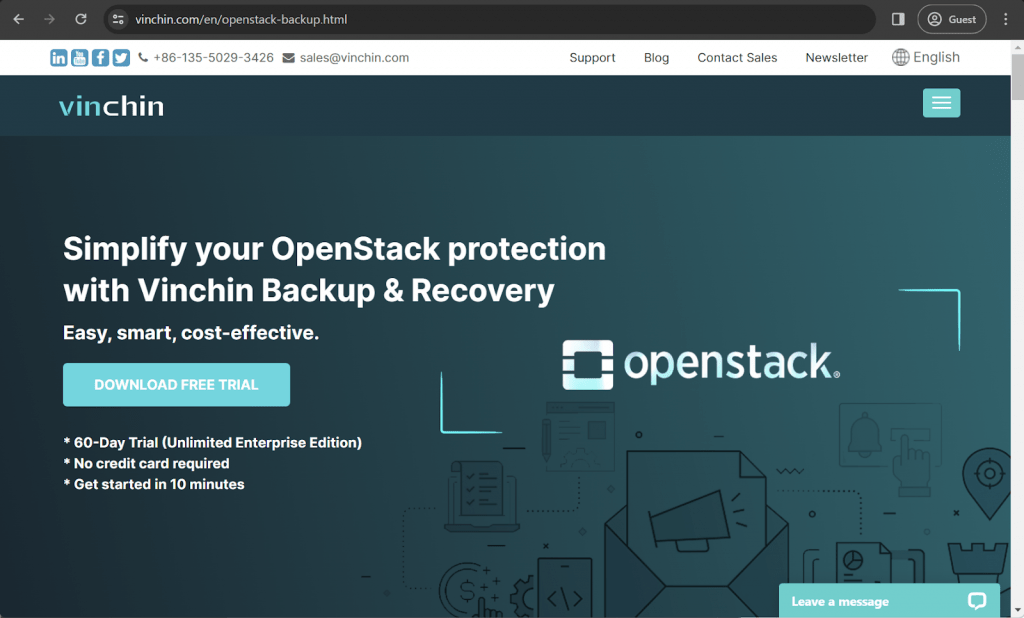
While Vinchin may not be the most widely recognized solution in the market, it boasts a substantial client base with thousands of customers worldwide. Vinchin Backup & Recovery is versatile, supporting various virtual platforms, including Hyper-V and VMware. It offers a user-friendly backup service along with a comprehensive disaster recovery service known for its exceptional performance. Vinchin’s backup approach is agentless and incremental, allowing for daily, monthly, or weekly backups. Its support of OpenStack brings a variety of advantages from Vinchin straight to OpenStack’s backups, including incredible performance, high levels of security, plenty of automation, and so on.
Customer ratings:
Advantages:
- Vinchin offers a wealth of features, even in its free version, providing users with a wide range of choices and capabilities.
- It facilitates data centralization through a dedicated dashboard, which enables comprehensive control over various backup-related aspects within the organization.
- The user interface of Vinchin is notably straightforward and user-friendly, simplifying the user experience.
Shortcomings:
- The quality of Vinchin’s reporting capabilities can vary depending on the report type. For instance, the email reporting feature is quite basic and provides limited customization options.
- Vinchin’s mobility options are somewhat restricted; it lacks a mobile app, and the GUI is not web-based. Consequently, accessing the solution outside the regular office environment may present challenges.
- Vinchin is limited in terms of backing up other technologies typically found in large and medium IT environments, so may be too limited for company-wide roll-out.
Pricing (at time of writing):
- Vinchin can offer multiple licensing types and pricing tiers for its customers. The pricing tiers are:
- Essential Edition for relatively small businesses that work with VMware or Hyper-V in their day-to-day operations without any kind of sizeable budget for a dedicated backup solution
- Standard Edition is targeted towards small to medium-sized businesses with a set of requirements that are a bit more specific when it comes to a backup solution – since their XenServer/VMware/Hyper-V infrastructure needs those in order to operate properly
- Enterprise Edition is the most suitable options for complex large-scale infrastructures that need a complex multi-functional backup system for their massive virtual infrastructure to be protected in its entirety
- Enterprise Plus Edition offers a comprehensive range of features and capabilities, making it an ideal choice for managing hybrid environments that encompass physical servers, databases, virtual machines (VMs), and more.
- There are two possible approaches to acquiring a Vinchin license – either a perpetual one or a subscription-based one:
- A subscription license offers the ability to subscribe to Vinchin’s services for a specific time period (from 12 to 36 months, in most cases), offering version updates, technical support, and so on.
- A perpetual license is a different approach that allows customers to purchase permanent licenses to software, but neither version updates nor technical support is included in this package
- When purchasing a perpetual license for the solution, the initial purchase includes one free year of “renewal services.” These renewal services encompass software updates and technical support. However, starting from the second year and beyond, the cost for these renewal services is 25% of the solution’s Manufacturer’s Suggested Retail Price, or MSRP.
- It’s not uncommon for software companies, especially those that offer enterprise solutions, to not disclose specific pricing on their websites. The pricing for enterprise software solutions like Vinchin may vary based on factors such as the number of users, the specific features and modules required, and the level of support and services requested. To obtain accurate pricing information for Vinchin, individuals or organizations interested in the software should reach out to the company directly and request a personalized quote.
My personal opinion on Vinchin:
Although Vinchin may not be as widely recognized as some other backup solutions, it has a dedicated user base. Vinchin stands out with its rich set of backup and recovery features, support for some other platforms, including VMware, and excellent overall performance. It is also quite competent when it comes to OpenStack backup capabilities, offering flexible approaches to backup performance, plenty of automation and scheduling capabilities, the potential for agentless backup reasonable ransomware protection, and more.
Commvault
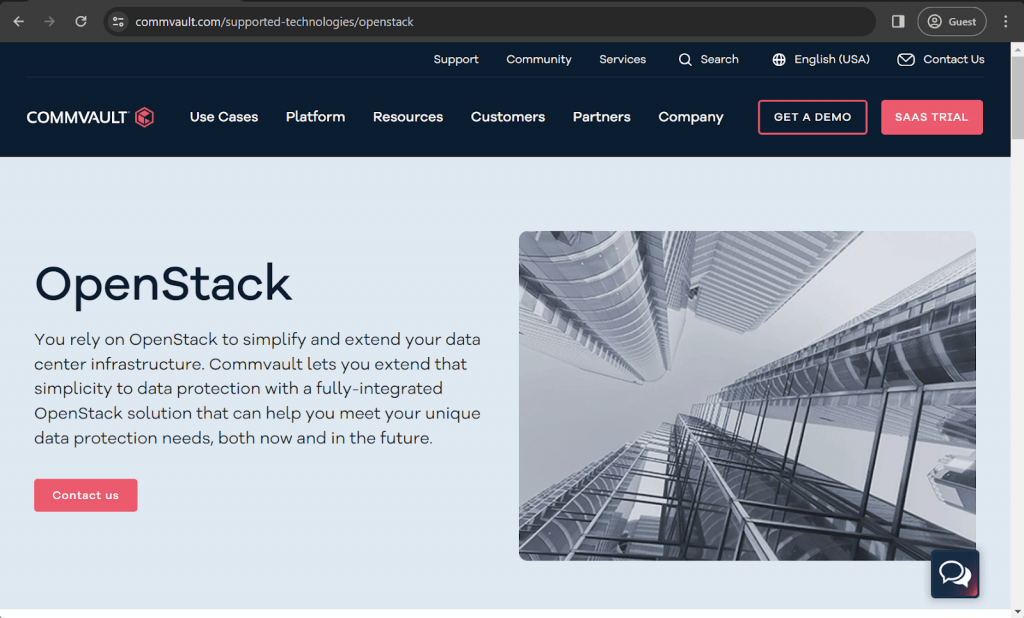
Commvault provides the convenience of restoring data through a centrally controlled management console, eliminating the necessity for administrators to work on-site. It streamlines backup systems, whether they are in the cloud or on-premise, by providing a centralized dashboard for monitoring and managing backups. Additionally, their “Edge Drive” feature enables users to utilize the system as a private cloud. In the context of OpenStack, Commvault employs a hot-add protection approach, making it convenient to swiftly deploy additional protection proxies as needed for your business. Commvault’s single management interface combines all configuration, management, and reporting tools into an easy-to-operate portal, significantly reducing the administrative workload.
Customer ratings:
- Capterra – 4.8/5 points and 9 user reviews
- TrustRadius – 7.8/10 points and 207 user reviews
- G2 – 4.2/5 points and 78 user reviews
Advantages:
- Commvault’s expansion options are not limited to scaling up in size; it can also scale horizontally by offering various integrations and supporting different storage types, providing flexibility and adaptability to evolving needs.
- The user experience is notably user-friendly, with most basic configuration tasks requiring minimal effort.
- Commvault demonstrates remarkable scalability, capable of expanding to accommodate even the most complex and sophisticated IT infrastructures. It uses both the Cinder and Nova elements to offer different approaches to Openstack backup.
Shortcomings:
- While Commvault does offer support for a wide range of containers, hypervisors, and database types, it’s important to note that it doesn’t support every infrastructure, necessitating a thorough review of the list of supported systems in advance.
- Basic reporting with limited details is a common challenge for many enterprise-level backup solutions, and Commvault is no exception, experiencing notable reporting issues across the board, except for specific integrations.
- One aspect to consider is that the pricing of Commvault often falls on the higher end, surpassing the market average and potentially exceeding the budget of most small and medium-sized businesses.
Pricing (at time of writing):
- Enterprise software pricing can vary widely based on factors such as the number of users, the specific modules and features required, and the level of support and services. To get accurate pricing information for Commvault, individuals or organizations interested in the software should contact the company directly.
- The unofficial information suggests that Commvault’s hardware appliances’ price ranges from $3,400 to $8,781 per month.
My personal opinion on Commvault:
Commvault stands out as a prominent player in the backup market, delivering robust functionality, a wide array of features, and extensive integrations. It offers support for a variety of storage types, including physical and cloud storage, as well as applications, databases, containers, and more. The centralized management console simplifies administrative tasks, and its scalability makes it well-suited for enterprise-level clients.Commvault has native integration into Cinder, and offers snapshot based backup.
Trilio
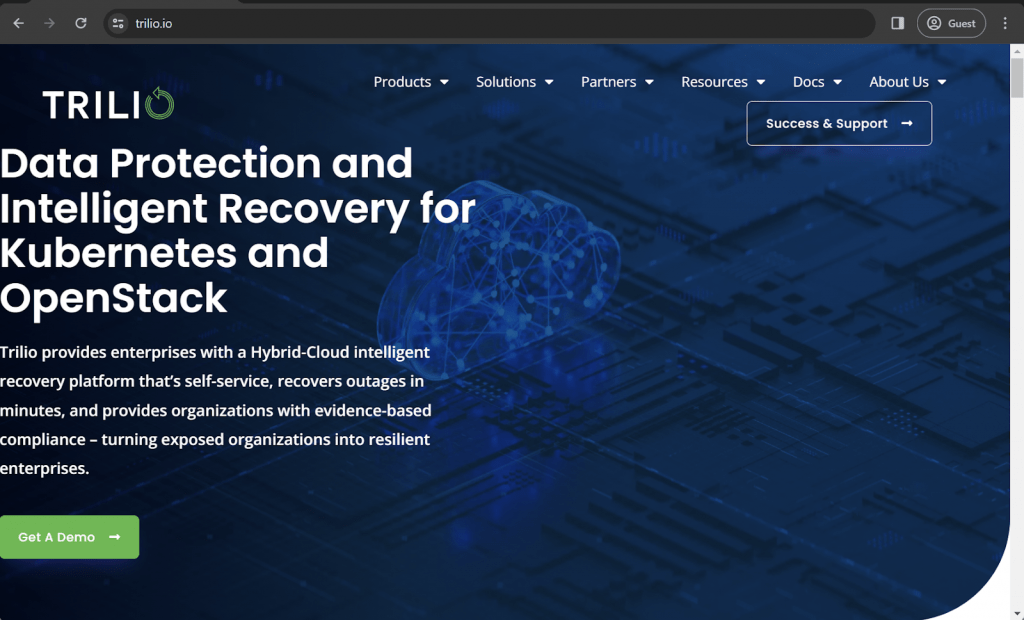
Trilio is a company that specializes in providing data protection and recovery solutions tailored for cloud-native environments, with a particular focus on OpenStack and Kubernetes. Trilio’s product offerings are designed to assist organizations in safeguarding their data, applications, and workloads within cloud and containerized settings. They aim to ensure data resiliency, backup, and disaster recovery capabilities for their customers. It is also heavily integrated with OpenStack to ensure better compatibility and versatility for all backup and disaster recovery operations.
Advantages:
- Trilio provides automation and policy-driven backup and recovery, reducing the manual effort required for managing backups and ensuring data protection compliance.
- Trilio’s approach to backups is application-centric, which means it captures not only data but also the entire state of an application. This ensures that applications and their dependencies can be accurately restored.
- Trilio solutions integrate with cloud and container orchestration platforms via either Cinder or Nova APIs, streamlining the backup and recovery process and making it easier for users to incorporate data protection into their existing workflows.
Shortcomings:
- Cloud-native technologies, including OpenStack, are evolving rapidly. Staying aligned with these technologies and ensuring that data protection solutions remain current can be a challenge.
- Managing data protection in complex cloud-native environments can be rather challenging. Trilio’s solutions need a certain level of expertise in order for them to be managed properly.
- While Trilio’s specialization in cloud-native environments is an advantage for organizations in these ecosystems, it may not be the ideal choice for those with more traditional or diverse infrastructure. Other solutions may be more suitable in those cases.
Pricing (at time of writing):
- The absence of pricing information on the official Trilio website is in line with the practices of many enterprise software companies. Enterprise software pricing often depends on various factors such as the number of users, specific features, and the level of support required, making it challenging to provide one-size-fits-all pricing. For those interested in Trilio’s solutions, the best way to obtain accurate pricing information is to contact the company directly.
My personal opinion on Trilio:
Trilio offers data protection and recovery solutions for cloud-native environments, and like any software, it comes with its own set of advantages and disadvantages. It supports multiple OpenStack distributions while offering a simple and effective way to create or restore backups. It is secure, scalable, agentless, and deeply integrated with OpenStack, making it a great option for businesses that rely on this particular infrastructure type often. Trilio is a rather case-specific solution that basically does not offer anything other than Kubernetes/OpenStack support, meaning that it is not on par with some other solutions on this list when it comes to the feature set beyond OpenStack support.
Storware Backup and Recovery
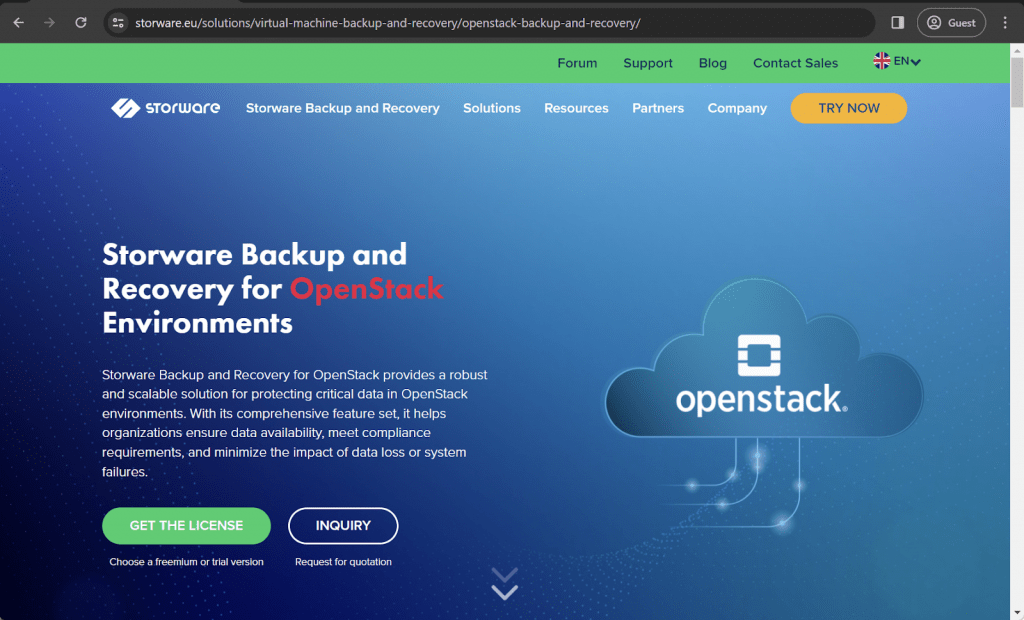
Storware Backup and Recovery, previously known as Storware vProtect, is a backup and recovery solution primarily designed for managing snapshots and backups across various container and virtual environments. It is known for its user-friendly interface, compatibility with multiple backup destinations, support for various virtual environments, and the availability of 24/7 customer support. Storware simplifies the intricacies of data protection for OpenStack, catering to the needs of both administrators and tenant users. This simplification, via Openstack’s Horizon interface, makes backup and disaster recovery processes more straightforward, and more effective than ever before, with exceptional scalability, efficient centralized management, and more.
Customer ratings:
- G2 – 4.7/5 stars based on 28 customer reviews
Advantages:
- The clean and simple graphical user interface (GUI) enhances the ease of managing backup and recovery operations.
- The agentless infrastructure eliminates the requirement for a physical centralized server for the entire solution to operate effectively.
- The initial configuration and setup process is notably straightforward, making it user-friendly.
Shortcomings:
- While the initial setup process is aided by a helpful online tutorial, it may not necessarily be inherently short or straightforward; the tutorial contributes to its simplicity.
- The configuration of retention policies could be more user-friendly, potentially requiring improvement in this aspect.
- There are limited options for customizing notifications, offering little flexibility in this regard.
Pricing (at time of writing):
- Storware’s official website showcases two different pricing plans:
- Freemium – a completely free offering with multiple limitations, be it 100 or less M365 users, 10 or less virtual environments, 1 TB data, 10 or less apps, etc. This version also offers everything Storware has to offer in terms of backup and recovery features.
- Trial – a full version of the solution for 60 days, no limitations in terms of workspaces and storage whatsoever, official support, and all of the backup/recovery features of Storware.
- Most of the enterprise-grade software does not have their pricing information available to the public, and Storware is no exception. Enterprise software pricing can vary significantly depending on factors such as the number of users, the specific modules or features needed, and the level of support and services required.
My personal opinion on Storware:
Storware is a rather unconventional backup solution as a whole, offering a significant focus on snapshot management for different platforms. It is fast, scalable, and has plenty of centralization options to work with, making it a good backup solution as a whole. One of many supported systems for Storware is OpenStack, to which it can offer data compression, various security options, backup granularity, snapshot integration, and plenty of other advantages that an average OpenStack user can find rather useful.
Hystax
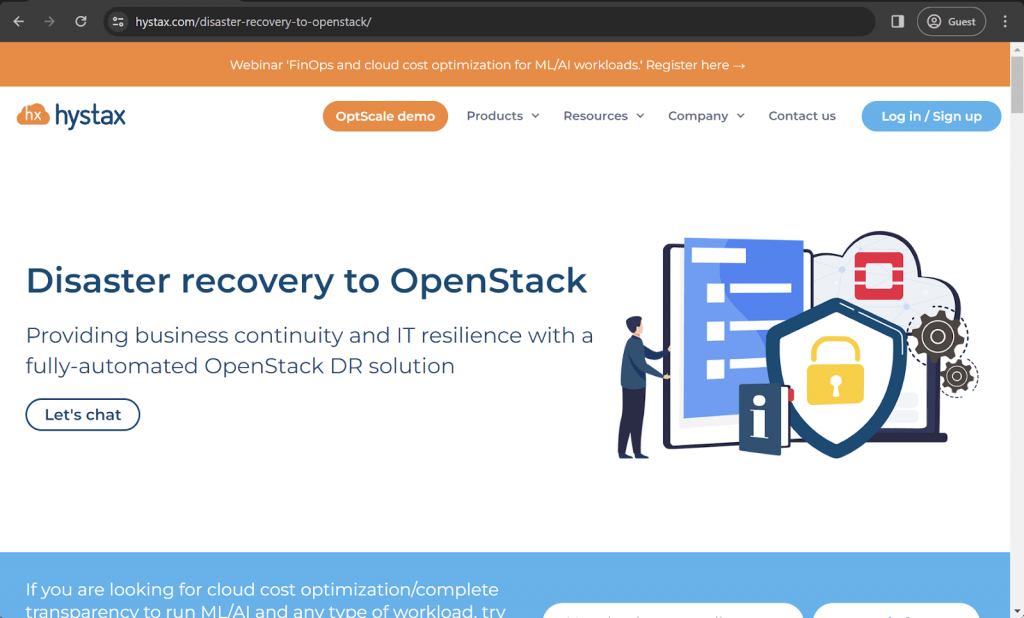
Hystax is a company that specializes in delivering solutions for cloud migration and disaster recovery. Their primary product, Hystax Acura, is an all-encompassing platform aimed at simplifying and enhancing cloud migrations while also providing robust disaster recovery features to guarantee the availability and continuity of essential workloads. Hystax is recognized for its solutions’ flexibility, efficiency, and user-friendliness, making them highly beneficial for businesses seeking to optimize their cloud strategies and protect their data and applications. It also has complete support of OpenStack, offering a fully-automated DR software with a variety of features that work for both partners and customers.
Key features:
- Exceptional performance across the board makes Hystax an interesting option for companies that prefer their RPOs and RTOs to be as low as possible.
- The platform also offers plenty of cloud management capabilities to its users, providing impressive control over the entire infrastructure with the addition of security-related features.
- Even though Hystax can work with both small and large-scale companies, it is still a very user-friendly solution at its core that can be picked up by practically anyone with no prior experience with such software.
Pricing (at time of writing):
- While Hystax does have pricing information available on the official website, it is only applicable to Hystax OptScale – another product from the same company that specializes in cloud cost optimization.
- Hystax Acura (the solution that offers cloud backup and disaster recovery capabilities) does not have any form of public pricing available on the official website. The only option to receive such information is to contact Hystax directly for either a demo or a personalized quote.
My personal opinion on Hystax:
Hystax is not a particularly large company by any means, it is one of the smallest software providers on this list. There are two main offerings from Hystax – Acura, which is a disaster recovery and cloud data management solution, and OptScale, a cloud cost optimization solution. Both of these options have a very specific target audience, and this may be one of the biggest weaknesses of Hystax – the need for a client to purchase another solution if their infrastructure goes beyond what Hystax can work with. Other than that, it is a great option for a very narrow set of use cases, including OpenStack coverage.
Ahsay
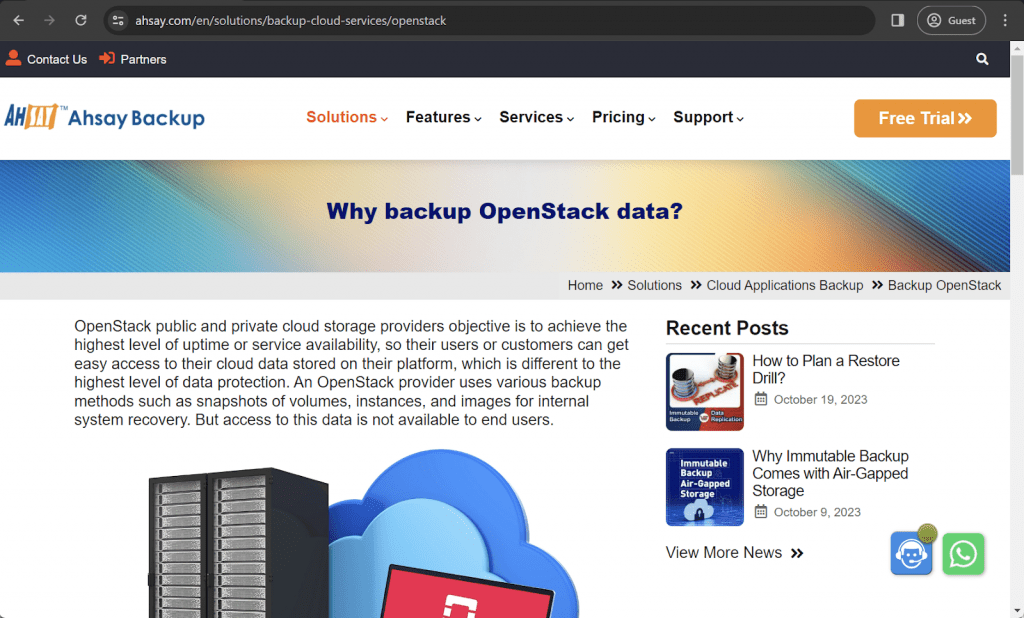
Ahsay is a renowned organization specializing in delivering backup and disaster recovery solutions tailored to meet the needs of businesses and managed service providers (MSPs). Their primary offering, the Ahsay Backup Software, is meticulously crafted to safeguard vital data and applications, offering a diverse set of backup and recovery functionalities. With an extensive history in the field of data protection and backup, Ahsay caters to a worldwide clientele with different use cases and situations, it can cover applications, cloud storage, FTP, SFTP, and even solutions such as OpenStack.
Customer ratings:
- Capterra – 3.9/5 stars based on 57 customer reviews
Key features:
- Ahsay’s solution supports various environments and infrastructures, including applications, databases, NAS, cloud storage, regular storage, and more.
- Ahsay’s security capabilities are on point, with mandatory encryption and plenty of other security-related options to choose from.
- Other features of Ahsay include data migration, data retention, deduplication, granular backup/restore, centralized management, and so on.
Pricing (at time of writing):
- Ahsay’s pricing model is fairly simple – its main solution called Ahsay Managed Backup-as-a-Service claims to cover practically any infrastructure type out there, including M365, MS Exchange, MySQL, Synology NAS, and many others.
- The price itself is calculated based on the amount of data produced, and there are different pricing rates for different data types.
- For example:
- 100 GB of regular files on physical storage or NAS costs $1.5 per month
- 100 GB of VM/Database files costs $2 per month
- 50 GB of data from Microsoft 365 within a single mailbox costs $2 per month, as well
- However, it is worth noting that the official pricing page does not mention OpenStack in any way, meaning that there is no way to predict the price of the solution aside from contacting Ahsay directly.
My personal opinion on Ahsay:
Ahsay is almost a complete opposite of the previous example (Hystax). It is provided using the as-a-service model, offering a complete dedicated infrastructure to a client. There is support for M365, Hyper-V, VMware, NAS, databases, applications, and some others. Ahsay does not limit its users in terms of how many different machines the software can be installed to, but it does calculate its pricing based on the amount of data produced – a rather divisive pricing model that may not be the best fit for some companies on this market. Ahsay doesn’t offer any special features for OpenStack backup, but it does have enough capabilities on its own to make the backup process relatively simple and easy in some cases.
Vembu BDR Suite
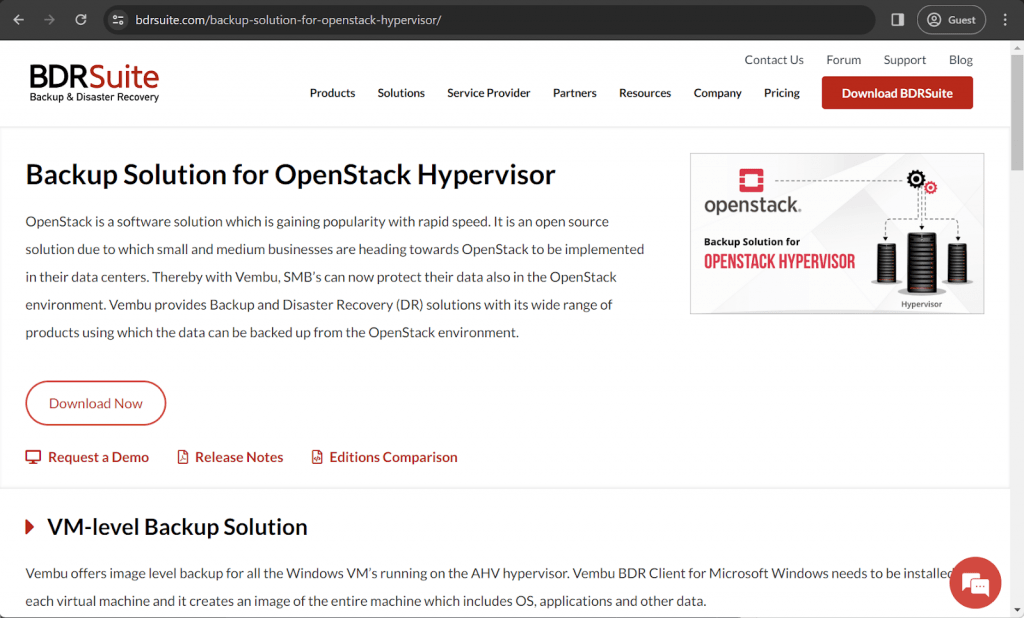
Vembu is a software provider that has garnered significant popularity over the years with different customer types. This popularity is the result of Vembu’s unusual combination of user-friendliness and flexibility in payment models. Vembu’s BDR Suite is a comprehensive collection of solutions designed for backups across various platforms, encompassing physical storage, virtual machines, cloud workloads, and more. This extensive coverage makes Vembu an appealing solution for maintaining backup operations across diverse environments and ensuring their seamless integration. Vembu’s capabilities in terms of OpenStack are not exactly unique, but there are still plenty of features to choose from – backup verification, app-aware backups, CTB support, retention policies support, and more.
Customer ratings:
- Capterra – 4.5/5 stars based on 17 customer reviews
- TrustRadius – 8.4/10 stars based on 88 customer reviews
- G2 – 4.2/5 stars based on 130 customer reviews
Advantages:
- The software includes a full-featured Linux version as part of its product offering, catering to a wider range of user preferences and requirements.
- Vembu is recognized for its customer support, which has garnered numerous positive reviews from satisfied users, underlining its commitment to service excellence.
- Vembu’s interface is web-based, it provides easy access to all of its features and capabilities, enhancing the user experience as a whole.
Shortcomings:
- One notable challenge with customer support is that a substantial portion of their knowledge is centered around the Windows version of Vembu, and it may not be entirely identical to the Linux version, leading to occasional confusion.
- It’s worth mentioning that the price tag of the BDR Suite is not particularly budget-friendly, and a recent across-the-board price increase has pushed it even higher, exceeding the market average.
- Although the user interface is user-friendly and easy to navigate, the solution as a whole presents a steep learning curve, which might require a significant amount of time for an average user to become proficient in utilizing all of its features.
- Limited scalability and not great for large or medium businesses.
Pricing:
- Vembu BDR Suite’s pricing varies quite a lot depending on the target data source:
- VM Backup – from $18 per year per VM, with support for both Hyper-V and VMware deployments
- Server Backup – from $60 per year per server, both Linux and Windows servers are supported
- Application/DB Backup – from $60 per year per application/database, can work with SQL, MySQL, and Exchange
- SaaS Backup – from $12 per year per user, works for Google Workspace and Microsoft 365
- Cloud VM Backup – from $30 per year per AWS instance
- Endpoint Backup – from $15 per year per endpoint, supports Windows and Mac devices
- It’s important to mention that many of the backup solutions within the BDR Suite by Vembu are available for free, offering most of their features with specific limitations on the number of workstations, virtual machines (VMs), or servers they can support.
- The official pricing page is where plenty of pricing-related information about Vembu BDR Suite is located.
My personal opinion on Vembu BDR:
Vembu is a well-regarded software provider in the realm of backup and recovery, with its BDR Suite often recognized as a comprehensive and feature-rich solution. What sets Vembu apart from much of the competition is its streamlined product offering, consisting of just two solutions. The second solution is essentially a scaled-down version of the BDR Suite, specifically tailored for cloud backups. Consequently, Vembu concentrates its entire feature set within these two solutions. It is not as integrated with OpenStack as some other solution examples on this list, but its large feature set may manage to compensate for that disadvantage in some cases. However, its lack of command line interface will be a concern to some.
Veritas NetBackup
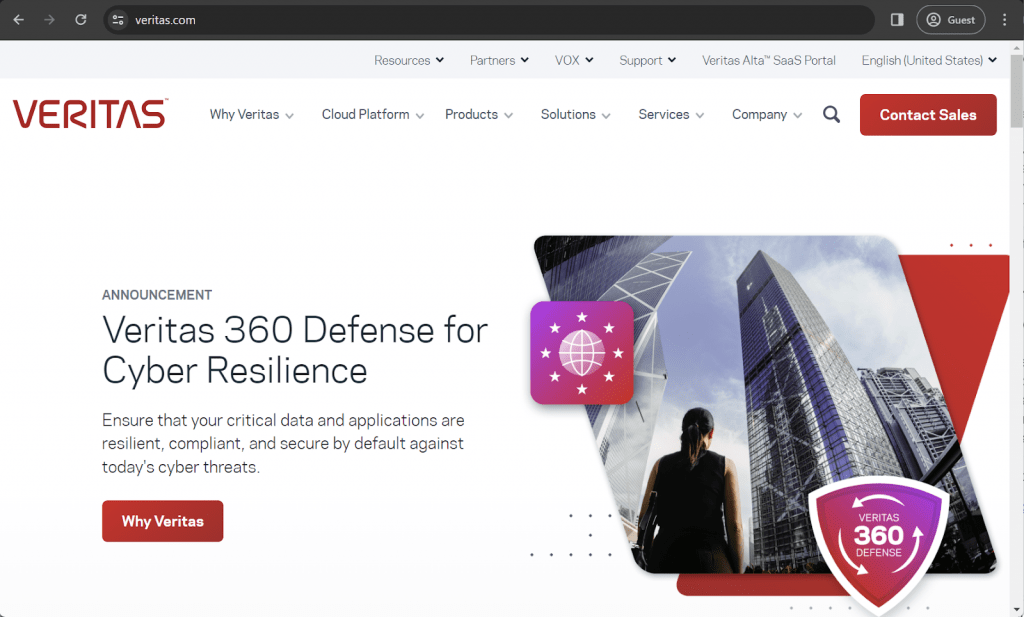
Veritas has established a longstanding presence in the industry, surpassing many of its competitors in terms of tenure. Over the years, the company has amassed an impressive portfolio of positive reviews and successful projects, making it a preferred choice for numerous large enterprises. Veritas’s reputation plays a significant role in its popularity. Of course, reputation is not everything, and Veritas also has plenty of features to choose from, be it information governance, software appliances, It can also create incremental or full snapshots of OpenStack workloads with ease, covering each workload type within the infrastructure.
Customer ratings:
- TrustRadius – 7.7/10 stars based on 86 customer reviews
- G2 – 4.0/5 stars based on 108 customer reviews
Advantages:
- Veritas NetBackup is highly adaptable, capable of seamlessly integrating with numerous cloud vendors and a diverse range of storage types when the need arises.
- A centralized management console simplifies the process of monitoring multiple backup processes and other tasks simultaneously, enhancing overall efficiency and oversight.
- Veritas is a versatile multiplatform product that boasts compatibility with heterogeneous operating systems, ensuring flexibility and broad support for various environments.
Shortcomings:
- Numerous reviews have expressed concerns about NetBackup’s interface, deeming it overly complicated and not particularly user-friendly, which may hinder user adoption and efficiency.
- Upgrading existing servers and migrating to different hardware can be exceedingly complex and prone to failure, even when all the required prerequisites are meticulously met, posing a considerable challenge.
- In certain scenarios, Veritas may encounter limitations in performing backup or recovery tasks through its graphical user interface (GUI), necessitating the use of a command line interface as the sole viable option for executing these operations.
Pricing:
- To get accurate pricing information for Veritas, individuals or organizations interested in the software should contact the company directly. Veritas itself does not disclose any information about its pricing to the public.
My personal opinion on Veritas:
Veritas is an established company with a long history, spanning several decades, during which it has offered a range of data protection solutions tailored to various use cases. NetBackup is among the selection of solutions provided by Veritas, able to do Openstack backups via Cinder and Manila. However, it’s important to acknowledge that NetBackup can also be rather intricate, particularly when it comes to its user interface. Many users encounter challenges with data migration, which can be problematic in most cases. Additionally, certain backup tasks may only be executed using the command line interface, which could be seen as a limitation. Prices can be expensive.
Zmanda
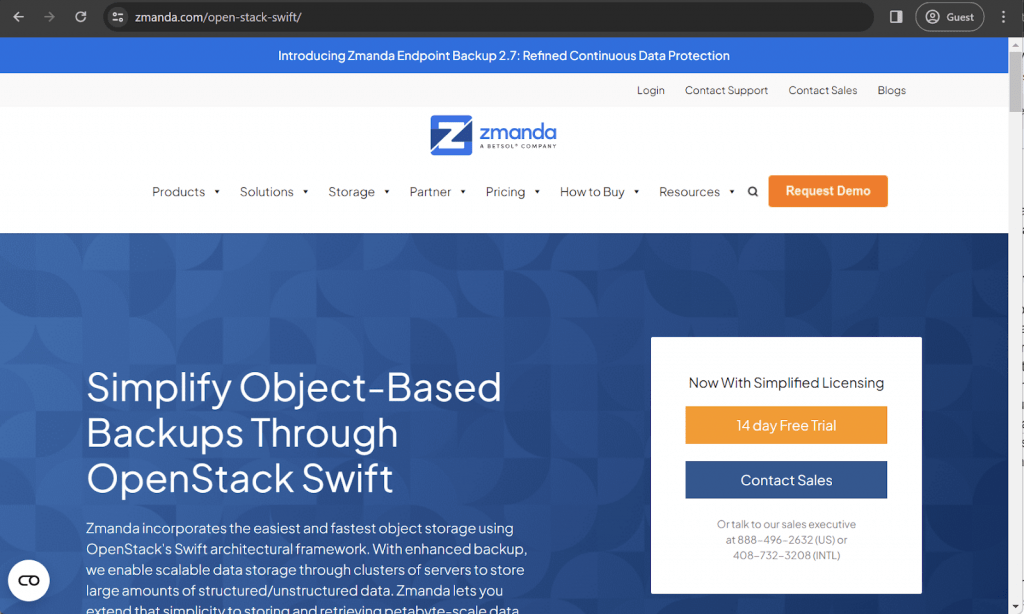
Zmanda is a software provider under the ownership of the BETSOL team, specializing in a wide array of solutions, including enterprise backup, cloud backup, managed cloud services, and various other offerings to cater to the diverse needs of its clients. Zmanda implements hot-add protection within the OpenStack environment (specifically via Openstack Swift), streamlining the process of safeguarding additional proxies. This approach ensures a swift and uncomplicated way to meet clients’ business objectives. There is also a unified management interface that consolidates all configuration, administration, and reporting tools into a user-friendly portal, significantly alleviating the administrative workload.
Key features:
- Extensive report generation, providing a comprehensive overview of each backed-up instance includes vital information such as the data size and the guest operating system.
- Support for both full and incremental backups is included, saving storage space and time spent on performing backups.
- The solution itself is agentless, it does not require a specific software to be installed on every single machine, the only step necessary is to install the Virtual Server Agent on an OpenStack instance.
- There are plenty of ways to customize backup and recovery tasks, including filters that let users exclude instances from the process when necessary.
Pricing (at time of writing):
- One of the biggest selling points of Zmanda is low pricing when compared directly with the competition. As such, Zmanda has a fairly simple pricing system that includes:
- $29.99 per physical server per month
- $2.99 per workstation per month
- $5.99 per VM per month
- $20 per 1 TB of cloud storage per month
- However, this particular option only applies to Zmanda Endpoint Backup and Recovery, while other backup solutions (such as Zmanda Recovery Manager) do not have any public pricing available on the official website at all – requesting a personalized quote is the only way to obtain such information, including any info about the price of Zmanda’s OpenStack coverage.
My personal opinion on Zmanda:
Zmanda is a fairly convenient backup and recovery solution for various storage types, and its OpenStack backup is quite effective – accessing the system via Swift and providing a wealth of different features to work with. It is quite confusing in terms of pricing, and some parts of the solution can be a bit too generalized and not descriptive enough, but the overall experience is noted as positive in most user reviews for Zmanda as a whole. Take note that Zmanda is not integrated with Cinder, and as a result may have certain backup limitations with the OpenStack environment.
How Bacula Enterprise approaches OpenStack backup and recovery tasks
Bacula Enterprise is the last solution on this list, and it is also the one that we will be talking about in a bit more detail than the rest.
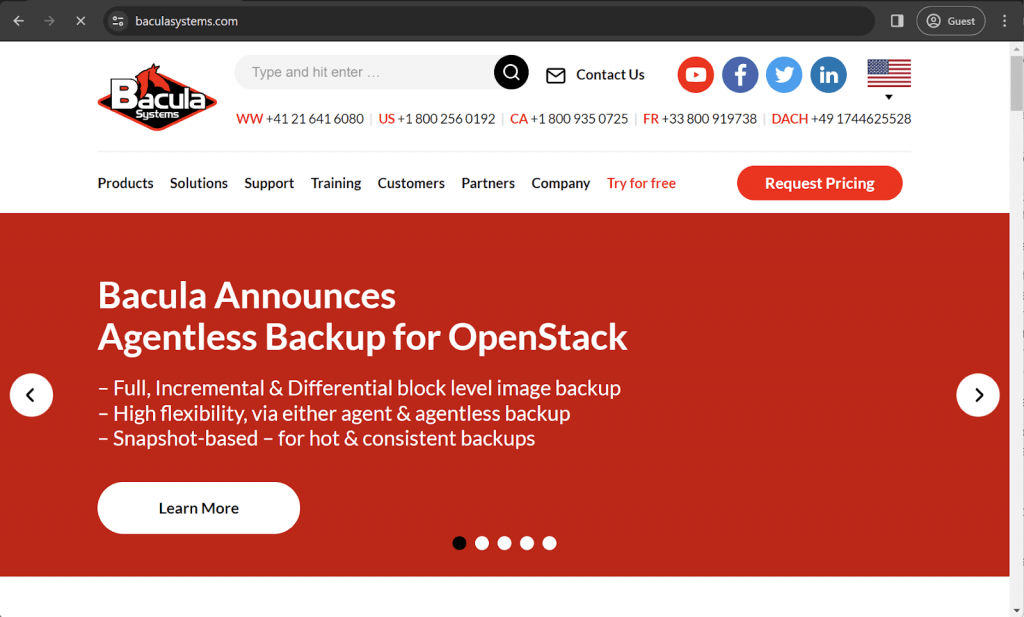
Bacula Enterprise stands as an especially highly secure, dependable backup and recovery software solution, offering a broad array of functionalities encompassing data backup, recovery, data protection, and disaster recovery capabilities. It is a highly secure and versatile solution with medium-sized and large organizations – especially government, defense, military and large research laboratories as its primary audience. Bacula Enterprise distinguishes itself by being extremely customizable, providing an extensive spectrum of features, ranging from versatile storage options and simplified setup to cost-effective deployment and remarkably rapid data recovery times. Its compatibility extends to a broad spectrum of operating systems, encompassing well over 34 operating system distributions including RedHat, Debian and Ubuntu, in addition to Microsoft, MacOS X, Solaris, and many more. Notably, Bacula boasts a unique scalable and modular architecture that enhances protection against threats like ransomware and other malicious attacks.
Customer ratings:
- TrustRadius – 9.7/10 points based on 54 customer reviews
- G2 – 4.7/5 points based on 56 customer reviews
Advantages:
- Supports an unusually wide variety of different storage types, including VMs, cloud interfaces, containers, databases, servers, and more.
- Extensive job scheduling greatly improves the overall convenience of protecting Openstack or any other software in question.
- Bacula Enterprise can be deployed in any combination of circumstances and takes its data security very seriously: for example, it is relied on by the largest defense organization in the West. Bacula’s ability of comprehensive Openstack backup brings the Openstack environment under Bacula’s advanced security umbrella.
Shortcomings:
- There are a number of additional plugins that are not included in the base package of the solution, requiring additional payment to be provided for them.
- The web interface is convenient, but can take a little time for newcomers due to the sheer number of different features available. Command line interface is also available, though.
- Bacula’s first-time setup over complex IT environments can take a while, although that is to be expected for one system that can span and protect many different technologies
Pricing:
- Contacting Bacula Systems directly is the only way to obtain exact pricing data since there is no public information about Bacula’s pricing available on the official website.
- However, there is some information about the overall pricing model of Bacula that can be found on that same website. For example, here are all of the pricing tiers available:
- BSBE – Bacula Small Business Edition, offers BWeb and web support and can only work with 2 contracts and 20 agents.
- Standard – up to 50 agents and 2 contracts, adds support answer deadlines (from 1 to 4 business days)
- Bronze – up to 200 agents and 2 contracts, offers phone support and shorter deadlines for customer support (from 6 hours to 4 days)
- Silver – up to 500 agents and 3 contracts, introduces a deduplication plugin and a lower customer support answer deadline (from 4 hours to 2 days)
- Gold – up to 2000 agents and 5 contracts, drastically reduces customer support answer deadline (from 1 hour to 2 days)
- Platinum – up to 5000 agents and 5 contracts, can offer PostgreSQL catalog support, as well as one training seat per year for Administrator courses
- Unofficial sources claim that Bacula Enterprise’s pricing starts at $500 per month
Now that we have a general understanding of Bacula Enterprise’s capabilities, it is time to talk about what Bacula is capable of in the field of OpenStack. It offers three different backup types (full, differential, incremental), all of which are image backups performed at block level. Bacula’s approach to OpenStack can be separated into two branches – the OpenStack Cinder module and the legacy Bacula File Daemon option (Bacula can, in many circumstances, also protect Openstack through its Swift module, although that is not covered here).
OpenStack backup with Bacula OpenStack Cinder module
With the Bacula OpenStack Cinder module, Bacula Enterprise’s Openstack-VM can very securely store all OpenStack volumes at the raw level, maintaining the integrity of data in the OpenStack context. Bacula’s Openstack-VM module efficiently retrieves and stores the content of OpenStack instances through the Cinder backup API. This module equips users with a range of command-line interface tools for executing backup, restoration, and resource management tasks.
The backup process for Cinder in the OpenStack environment, when facilitated by Bacula, is straightforward and can be initiated by executing specific Cinder-related backup commands within Bacula Enterprise. This method ensures a quick, efficient, and hassle-free solution, particularly when compared to alternatives offered by other vendors. Furthermore, Bacula’s integration with OpenStack tools through the driver allows OpenStack administrators to oversee their backups not only via a Bacula scheduler but also through various other means, providing a high level of flexibility and ease of management.
Bacula’s OpenStack module operates by backing up single volume-attached instances. The process itself is not particularly complex, but it does have a number of operations that exist for every single file that gets backed up with this module. That way, the OpenStack Cinder module:
- Performs a volume snapshot.
- Keeps track of all of the backup file names.
- Creates a “pipe” for data transfer from OpenStack to Bacula
- Generates and sends a synchronization command to Bacula in order for the “pipe” to be registered by the system
- Uses the “pipe” for Cinder to write in
The approach described above offers exceptional levels of reliability, precision, speed, and simplicity in the realm of OpenStack backups when compared to alternative solutions. This module equips users with a variety of command-line interface procedures to seamlessly execute backup, restoration, and resource management tasks, ensuring a robust and efficient backup process.
Here is how the backup prompt would look like:
- Closing the “pipe”
- Generating logs based on information received from Bacula
- Checking both the overall job status and the list of backed-up files
- Erasing all of the “pipes” that were used for backup
The newly created backup immediately falls under all of the general Bacula Enterprise features, such as encryption, deduplication, and many others. The data that has been backed up can be stored in multiple locations, including tape, disk, the cloud, or any other preferred storage destination, all conveniently managed through Bacula’s command-line interface.
Furthermore, the Bacula OpenStack module provides various options, one of which is the capability to back up all volumes connected to a specific instance using its unique ID. To obtain the ID of a particular instance, Bacula’s query procedure can be employed, enabling users to tailor their backup strategies to their precise needs and requirements.
Here is how Bacula’s query command may look like (the input is expected to be in json):
OpenStack backup via Bacula File Daemon
It is also possible to back up OpenStack data using the legacy method – via the Bacula File Daemon. This is a traditional agent-based approach to backup and recovery operations, it requires the File Daemon in question to be placed on the specific element of OpenStack that needs to be backed up. This means that the overall setup for backup tasks is a bit more convoluted than with the Cinder module.
The installation of a Bacula Enterprise File Daemon on each virtual machine empowers users to manage virtual servers in a manner similar to physical servers, enabling them to harness the full array of features provided by Bacula Enterprise for their backup and recovery needs. This includes file-level compression, data verification, ransomware protection, quick granular restoration, and more.
This approach optimizes the Input/Output (I/O) utilization within the OpenStack environment. Users can take advantage of Bacula’s scheduling, job priorities, and maximum concurrent job settings to effectively distribute backup tasks across the designated backup window.
Since all virtual machines may potentially share the same storage on the OpenStack hypervisor, thoughtful planning is necessary to avoid running all backup jobs simultaneously, thus preventing potential bottlenecks within the disk and network subsystem. This is because Bacula needs to traverse all file systems to open, read, close, and stat files during the backup process.
Conclusion
It is widely recognized that technology and innovation in the IT sector will continue to advance rapidly, particularly in domains like automation, digitization, the proliferation of data sources, and increasingly accelerated development cycles. As these new technologies are deployed in production IT environments, it becomes imperative to ensure the proper backup of mission-critical data and applications, not only to safeguard an organization’s business but also to protect its customers.
However, the challenge lies in seamlessly integrating a backup and recovery solution into these emerging technologies while still adhering to the organization’s specific business requirements, including Recovery Point Objectives (RPOs) and Recovery Time Objectives (RTOs). Bacula Enterprise’s backup and recovery software addresses these challenges through its distinctive design, flexibility, depth, and licensing model. This unique structure allows Bacula Enterprise to effectively resolve the issues related to data backup, recovery, and disaster recovery. In doing so, it empowers medium and large enterprises to enhance their efficiency, security, and competitiveness, ensuring the continuity and integrity of their IT operations.
Bacula offers an exceptionally secure, unified data backup and recovery software solution with an architecture that seamlessly integrates with a diverse spectrum of applications commonly associated with OpenStack environments. Additionally, it extends its compatibility to encompass various other emerging technologies, including virtual machines, containers, storage, and cloud environments. This comprehensive approach enables enterprises utilizing Bacula to efficiently adapt to evolving security demands, changing regulations, and the imperative for cost reduction.





Its a splendid post and exceptionally astounding, appreciation for this data. You are providing better data.